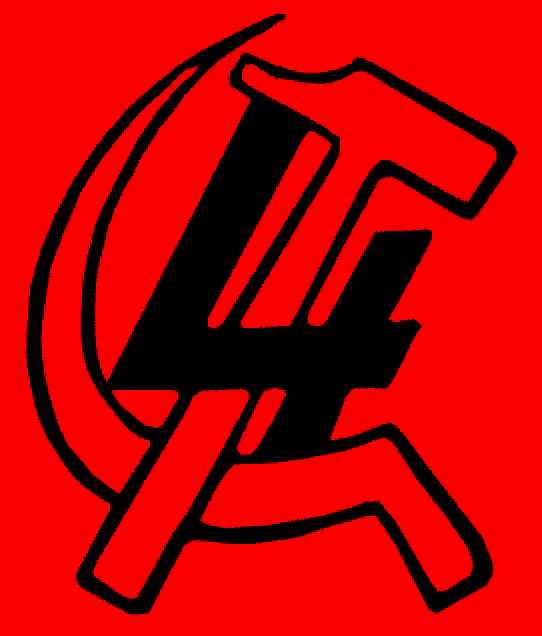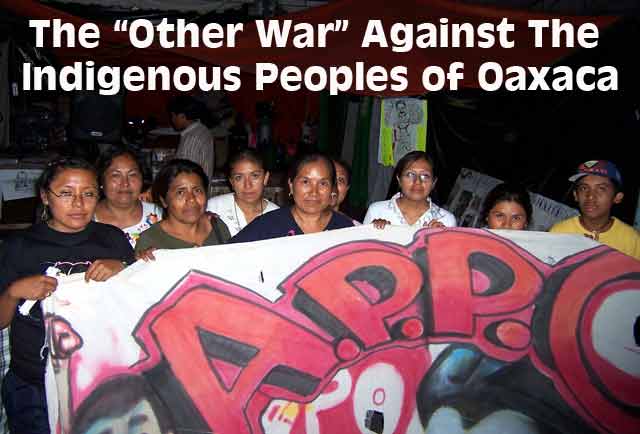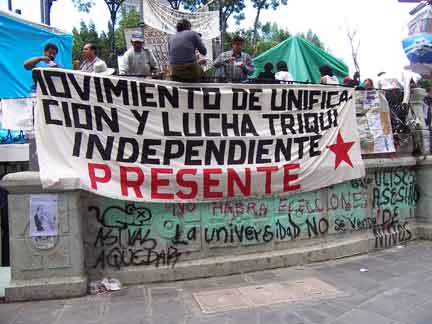
November 2006

The
discrimination against and exclusion of the indigenous population is
one of the
fundamental causes of the Oaxaca rebellion. No one can ignore it in the
land of
Benito Juárez, the Zapotec Indian who became president of Mexico
in 1858 and
led the War of the Reform against church power and the resistance to
the empire
of Maximilian1.
The Popular
Assembly of the Peoples of Oaxaca (APPO) recognized this in the
resolutions of
the forum on “governability” which it called in mid-August.
However,
the Indian question is not limited to the legal framework or democratic
rights,
nor to the removal of this or that cacique (political boss), or
even the
whole cacique system promoted by the PRI (Institutional
Revolutionary
Party). To liberate the descendents of the original inhabitants from
the weight
of half a millenium of plundering, superexploitation and even genocide,
both
under colonial rule and the republic, will take a social revolution.
Only the
taking of power by the Mexican working class will make it possible to
shatter
the power of a bourgeois and even oligarchic ruling class in states
like
Oaxaca, where their fabulous riches are extracted from the sweat of
indigenous
working people.
The criollo
(European-derived) caste which rules Oaxaca is extremely
tight-knit: its
members see each other in sumptuous feasts held in luxury hotels and
the
exquisite restaurants which abound in this colonial city; they visit
each
other’s estates to admire the prize bulls and purebred horses. The
political bosses
maintain gangs of gunmen and thugs commanded by corrupt deputies and
congressmen to assassinate rebellious teachers. The oligarchs
flamboyantly
wheel around town in their latest-model SUVs with oversized tires and
polarized
windows – known as “garcmobiles” during the El Salvador civil war of
the 1980s
– from which demoiselles in party dresses alight to attend their
elegant
fiestas. Their offspring practice endogamy, marrying only within the
caste, and
they all display openly racist contempt for those with dark skin.
These
are the “powers that be” who lord it over the state of Oaxaca, and they
were
the ones who came out on November 1 in a PRI march to support Governor
Ulises
Ruiz Ortiz. They wanted a “cleaned-up” city, some ladies told an
American
reporter, claiming that a majority of the “appos” are from Chiapas or
Guatemala
(i.e., they are Indian “foreigners”) and that the leader of teachers
union Section
22 is a muxe (transvestite). The reporter, James Daria, noted
the “deep
seated economic and racial conflicts underlying the current social
unrest” (Narco
News Bulletin, 1 November). The deepest of these is the Indian
question.
“We
have already been warned … they already have their cuernos [de
chivo,
goat’s horn, nickname for AK-47 automatic rifles) ready for when the
damn
Indians of the APPO show up,” remarked a rich cattleman of the lower
Mixe
region, according to Carlos Beas Torres, a leader of the UCIZONI
indigenous
organization (La Jornada, 16 October). The striking teachers
have raised
among their demands defense of bilingual education against budget cuts
which
have hit hard against instruction in Indian languages. Meanwhile,
PRI-linked
paramilitaries have made death threats against the coordinators of
radio Huave
(the most powerful community radio station in the Isthmus of
Tehuantepec),
Radio Ayuuk and Radio Umalalang.
This “other war” against the indigenous
peoples is not
limited to threats: in early August when a delegation of a Triqui
Indian
organization, MULTI (Movimiento de Unificación y Lucha Triqui
Independiente),
set off to reinforce the teachers’ encampment in the Oaxacan capital,
they fell
into an ambush which left three Triqui Indians dead (Andrés
Santiago Cruz,
Pedro Martínez Martínez and the youth Octavio
Martínez Martínez) and four wounded.
And on October 18, a teacher of bilingual primary school,
Pánfilo Hernández of
Zimatlán, was murdered as he left an APPO meeting.
Nor
is this war new. The Triquis, ensconced in the Mixtec region of western
Oaxaca,
have been the target of constant aggression by the state and federal
governments in support of PRI caciques, leading to the murder
of many
fighters for Indian rights going back to the 1970s. Among those killed
are
Guadalupe Flores Villanueva, Luis Flores García, Nicolás
López Pérez, Eduardo
González Santiago, Efrrén Zanabriga Eufrasio, Pedro
Ramírez, Javier Santiago
Ojeda, Paulino Martínez Delia and Bonifacio Martínez.
Another of the murdered
activists in previous years was Bartolomé Chávez of the
CIPO (Popular Indian
Congress of Oaxaca).
 Banner of
the MULTI in the Oaxaca Zócalo, August 2006.
Banner of
the MULTI in the Oaxaca Zócalo, August 2006.
(Photo: El Internacionalista)
With
1.6 million Indians, more than half the total population, Oaxaca is the
state
with the highest percentage of the population who speak indigenous
languages
(37 percent, compared to 24 percent in Chiapas), including Zapoteco,
Mixteco,
Mazateco, Chinanteco, Mixe, Triqui and ten additional ethnic groups. Of
the 570
municipalities in the state, 412 are governed according to indigenous
“usages
and customs,” under which municipal posts are determined by a rotating
series
of positions or obligations (cargos) and general assemblies make
decisions by consensus.
Although
they are less corrupt than many other local governments, one doesn’t
have to
idealize the traditional indigenous governments. There are also PRI
Indian caciques,
and in a significant number of Indian communities (around 20 percent),
even in
the late 1990s, women didn’t have the right to vote. There is also
little
presence of women in the leadership bodies of Section 22, even though
women
make up a clear majority of Oaxacan teachers.
The centrality of
the oppression of
indigenous peoples in the present struggle in Oaxaca is widely
recognized. In
the APPO forum, resolutions called for a new state constitution to
include
“juridical recognition of the original peoples and their rights, among
them the
use of indigenous languages and acceptance of the accords of San
Andrés Larráinzar.”
However, neither legal recognition nor the autonomy codified in the San
Andrés
accords, negotiated with the Zapatista Army of National Liberation
(EZLN) after
the Chiapas rebellion of 1994, offer a solution to the profound social
oppression of the indigenous peoples. This oppression is rooted in capitalism.
Just
to cite some indicative figures: the areas of Oaxaca populated by
Indian
peoples are the most backward in terms of education and in the state as
a
whole, 27 percent of women are illiterate while 34 percent of primary
school
age children do not attend school. The poverty is enormous: 70 percent
of the
Oaxaca population earns less than 70 pesos (US$6.50) a day. 55 percent
of homes
lack sewage connections or any drainage, while 40 percent of the houses
have
dirt floors, according to statistics of the INEGI (National Institute
of
Geography and Statistics) based on the 2000 census. Currently, poor
Indians
feel particularly threatened by the Plan Puebla-Panamá, which
has led to
massive buying up of Indian lands by speculators who want to grab a
corridor
alongside the superhighway.
We
have written extensively about the struggle against the oppression of
indigenous peoples in Latin America, calling in several Andean
countries for a
workers, peasants and Indian government (“see Marxism and the Indian
Question
in Ecuador,” The Internationalist No. 17, October-November
2003). This
demand would also be appropriate at the state level in Oaxaca. In
Mexico as a
whole, where the weight of the Indian population is substantially less,
the demands
of the EZLN and the Indigenous National Congress (CNI) center on
indigenous
autonomy, as laid out in the San Andrés accords which were
turned down by the
National Congress (with the connivance, it should be noted, of the
PRD). As we
wrote concerning Chiapas:
“Marxists support the right
of the native peoples to decide their own fate. For the areas where
Indians are
concentrated, we join in demanding the right of regional and local
autonomy.
For this to have any reality, it must include control over natural
resources,
including land, water and petroleum. This will be strenuously resisted
by
Mexico’s capitalist rulers, as the state of Chiapas, where the Mayan
Indians
live in pervasive poverty, produces 21 percent of the country’s oil
output, 47
percent of its natural gas, and 55-60 percent of total electrical
production,
mainly from hydroelectric stations….
“Effective autonomy for
indigenous peoples will only be possible through socialist revolution
instituting a planned economy.”
–“Mexico: Regime in Crisis,”
Part 2, The Internationalist No. 2, April-May 1997
Oaxaca
does not have huge natural resources like Chiapas, but there is another
reason
why genuine regional autonomy cannot be realized within a bourgeois
framework.
The peasant Indian economy is deeply threatened by the capitalist
market, which
is the ultimate cause of the poverty in which the indigenous peoples
live. This
has been the case since the triumph of capitalism in the Mexican
countryside in
the last half of the 19th century, but its effects have been
accentuated in the
last decade by the Free Trade Agreement with the United States, which
has led
to the importing of massive quantities of corn and the ruin of Oaxaca’s
peasant
agriculture.
Despite
its rhetorical identification with the Mexican Revolution, the PRI
arose from
the layer of Northern ranchers (Obregón, Carranza) who were
responsible for the
assassination of Emiliano Zapata and Francisco Villa and the defeat of
the poor
and landless peasants. The same ranchers are still in power in Oaxaca,
and
following their class interests they identify with the hacienda owner
from Guanajuato,
President Fox. Expropriating their estates will be one of the first
steps of
any social revolution.
Yet
not even Zapata’s old program of “land to the tiller” will be
sufficient to
deal with this. Almost half of the cultivated land in Oaxaca is under a
communal regime, another quarter is in the ejido2
system, with little more than a quarter held as private property. Even
with
collective cultivation of the land, the urgently needed agrarian
revolution
in the Mexican countryside requires the industrialization of
agricultural
production, which will only be carried out to the benefit of the
indigenous
peasants in the framework of a socialized economy.
It
is also essential to break with all the bourgeois parties. The most
important
struggle of the Oaxacan Indians in the past was that of the COCEI
(Worker-Peasant-Student Coalition of the Isthmus) centered on
Juchitán, dating
from the mid-1970s. For a time, the COCEI was allied with the Mexican
Communist
Party, and COCEI members were always treated as communists by the PRI caciques.
With the dissolution of the remnants of the CP into the Party of the
Democratic
Revolution, the COCEI also joined the PRD.
After
many years of mobilization, the COCEI achieved power locally. However,
as
members of a capitalist party, the Juchitán COCEI/PRDers have
aligned with the
rulers of the state and played a markedly conservative role – to the
point that
in the current struggle, a significant number of teachers in
Juchitán broke the
strike. It is notable that the only place in the state where there was
a
significant amount of scabbing was precisely in this stronghold of the
PRD.
The
struggle to defend the original peoples is also not identical to zapatismo,
although the appearance of the EZLN in 1994 did attract a great deal of
attention to the conditions of Indians in Mexico. The political support
which
the EZLN gave for many years to the PRD didn’t help indigenous peoples
in
Chiapas or the rest of the country, as Subcomandante Marcos himself
admitted in
his June 2005 Sixth Declaration of the Lacandón Jungle.
In
August 2005, a meeting was held in a Zapatista community bringing
together
indigenous representatives from all over Mexico. Spokesmen for the CIPO
complained:
“It
saddens us to see that the EZLN says something when something happens
to those
who are well-known, yet when blows are struck against communities,
organizations
and persons who are small, simple and little-known, they say nothing.
“We
perceive a differential treatment by the EZLN, which on the hand gives
priority
to its ties to the world of the NGOs3
and organizations who carry out little or no work with the ranks, while
it
leaves aside the rank-and-file indigenous movement, which actually goes
out
into the streets and fights alongside us.”
It is no accident, then, that during the
current
teachers strike in Oaxaca, even though it has involved hundreds of
thousands of
indigenous people, the EZLN and its “Other Campaign” have played no
role at
all.
1 Benito Juárez, 1806-1872,
became president of Mexico when civil war broke out in 1858 over a
series of
liberal reform laws establishing the separation of church and state and
curtailing ecclesiastical power. After three years of fighting, the
liberals
led by Juárez triumphed. However, when the liberal government
had to suspend
payment of interest on foreign loans, its main creditors, England,
France and
Spain, sent forces to seize the Veracruz customs house. Louis
Napoléon, the
emperor of France, then decided to occupy the whole of the country, and
with
the connivance of Mexican monarchists he selected Maximilian I of the
Austrian
Habsburg ruling house to be emperor of Mexico. Juárez retreated
to the north
where he established an “itinerant republic.” After the defeat of the
South in
the American Civil War, Napoléon withdrew his support from
Maximilian. When
French troops pulled out, the republican forces led by Juárez
retook the
capital in early 1867.
2 Ejidos were lands reserved for common use of the indigenous population during colonial times; under the land reforms following the Mexican Revolution of 1910-17, in Indian areas land was collectively owned by the community as ejidos and periodically parceled out among the members, although generally cultivated in individual family plots.
3 Non-Governmental
Organizations. While supposedly not (directly) funded by local
governments,
many NGOs are funded by imperialist foundations and governments,
particularly
the U.S.
See also:
To contact the Internationalist Group and the League for the Fourth International, send e-mail to: internationalistgroup@msn.com